


FRANZ JOSEPH HAYDN 1732 - 1809
(G2, G3a, G3b, G3c)
xxxxxThe Austrian composer Franz Joseph Haydn, one of the great composers of the Classical Period, has been called the father of the symphony, and the founder of the string quartet. He was also a leading exponent of the sonata, and he produced operas, songs, choral work, and a vast amount of church and chamber music. Most of this was composed during his 30 years of service at the court of Esterhazy at Eisenstadt, Austria (1761-1790). A great friend of his fellow countryman and musician Mozart, and a teacher to the German composer Beethoven, he made two visits to England, 1791 and 1794. During his highly successful visits he produced his twelve London Symphonies, a form which he developed and enriched during his career. Notable, too, was his oratorio The Creation, an inspired work produced in Vienna in 1798. He was a master of instrumentation, and innovative across a wide variety of musical form. In general his music was light hearted, free flowing, and full of fresh, beautiful melodies, many based on folksongs. The humour and sparkle of his music was to be in stark contrast to the sombre mood and intensity of feeling which typified the music of the Romantic movement of the 19th century.
Including:
Charles Burney

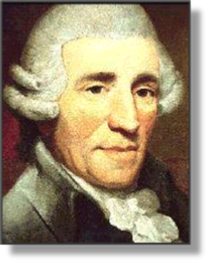 xxxxxThe Austrian Franz Joseph Haydn was one of the great composers of the Classical Period, alongside Wolfgang Amadeus Mozart and Ludwig van Beethoven. He has been called the father of the symphony - a form he did much to enrich - and the founder of the string quartet. He was also a leading exponent of the keyboard sonata, and his choral work included his two famous oratorios, The Creation and The Seasons. In addition, he composed operas, songs, and a vast amount of church and chamber music. By all accounts, he was a charming and good natured man, who wrote his music so that, as he put it, the weary and heavy-laden “might enjoy a few minutes of solace and refreshment”.
xxxxxThe Austrian Franz Joseph Haydn was one of the great composers of the Classical Period, alongside Wolfgang Amadeus Mozart and Ludwig van Beethoven. He has been called the father of the symphony - a form he did much to enrich - and the founder of the string quartet. He was also a leading exponent of the keyboard sonata, and his choral work included his two famous oratorios, The Creation and The Seasons. In addition, he composed operas, songs, and a vast amount of church and chamber music. By all accounts, he was a charming and good natured man, who wrote his music so that, as he put it, the weary and heavy-laden “might enjoy a few minutes of solace and refreshment”.
xxxxxHe was born of humble parents in the village of Rohrau, near Vienna (birthplace illustrated), and showed musical ability at an early age. As a boy he joined the school and choir at Saint Stephen’s Cathedral, Vienna, and then studied and worked in this city as a young man, struggling to make a living as a free lance musician. In 1758 he managed to obtain the post of musical director to Count Ferdinand 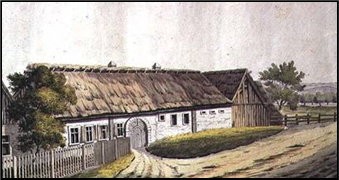 Maximilian von Morzin on his estate near Pizen, Bohemia, but three years later was appointed court musician to the wealthy and influential Prince Paul Anton Esterhazy at Eisenstadt in Austria. This marked a turning point in his career. The prince died the following year, but he then stayed on in the service of his brother Miklos - a great lover of music - serving him for close on thirty years and becoming his director of music in 1766.
Maximilian von Morzin on his estate near Pizen, Bohemia, but three years later was appointed court musician to the wealthy and influential Prince Paul Anton Esterhazy at Eisenstadt in Austria. This marked a turning point in his career. The prince died the following year, but he then stayed on in the service of his brother Miklos - a great lover of music - serving him for close on thirty years and becoming his director of music in 1766.
xxxxxThese years at the court of Esterhazy were highly productive ones, and gave him practical experience in almost the entire range of musical form. As part of a strict regime, he provided a daily performance of chamber music and, during the week, was responsible for the production of two operas and two formal concerts. As a result, most of his operas - some 25 in number - and the majority of his 107 symphonies and 68 string quarters, were composed during this period, not to mention 125 trios and 5 masses. And it was throughout these years that he did so much to develop and enhance the four-movement symphony, the string quartet, and the keyboard sonata - the corner stones of the classical style - then replacing the baroque music exemplified by Johann Sebastian Bach and George Frederic Handel. He worked long hours, and his duties were demanding, but he enjoyed some perks. Notable amongst these was his right, granted in 1779, to accept commissions and sell his music to publishers. This not only helped him financially, but also meant that his music came to be appreciated throughout Europe.
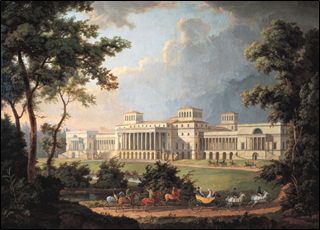 xxxxxWithin a short time of working at Eisenstadt his musical talent had come to be well known in Vienna, some 30 miles away. He made frequent visits to this city and it was here in the 1780s that he struck up a close friendship with his fellow countryman, the brilliant composer Wolfgang Amadeus Mozart, a friendship which proved of musical benefit to both men. And it was here, too, that for a brief time, having met him in 1792, he taught the equally talented German musician Ludwig van Beethoven, a man who much admired Haydn’s works.
xxxxxWithin a short time of working at Eisenstadt his musical talent had come to be well known in Vienna, some 30 miles away. He made frequent visits to this city and it was here in the 1780s that he struck up a close friendship with his fellow countryman, the brilliant composer Wolfgang Amadeus Mozart, a friendship which proved of musical benefit to both men. And it was here, too, that for a brief time, having met him in 1792, he taught the equally talented German musician Ludwig van Beethoven, a man who much admired Haydn’s works.
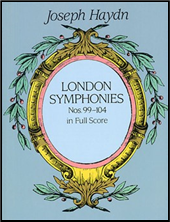 xxxxxWith the death of Prince Miklos in 1790, Haydn’s life changed dramatically. His son Antal had little interest in music so, although Haydn remained as music director, he was not required to provide any performances. For the first time in 30 years he was a free man. It was in that year, therefore, that he accepted an invitation to go to London for a series of public concerts. He arrived in England in 1791 - on New Year’s Day in fact - and stayed for eighteen months. Here he was entertained by royalty, feted wherever he went, and given an honorary doctorate in music by Oxford University. Indeed, so successful was his visit that, he returned for a second stay in 1794. The warmth of the reception that he received in London, together with his new found freedom, clearly inspired him to new heights of achievement. His twelve “London Symphonies” (numbers 93 to 104), known under popular titles like Surprise, Military and Clock, are the masterpieces within his orchestral work.
xxxxxWith the death of Prince Miklos in 1790, Haydn’s life changed dramatically. His son Antal had little interest in music so, although Haydn remained as music director, he was not required to provide any performances. For the first time in 30 years he was a free man. It was in that year, therefore, that he accepted an invitation to go to London for a series of public concerts. He arrived in England in 1791 - on New Year’s Day in fact - and stayed for eighteen months. Here he was entertained by royalty, feted wherever he went, and given an honorary doctorate in music by Oxford University. Indeed, so successful was his visit that, he returned for a second stay in 1794. The warmth of the reception that he received in London, together with his new found freedom, clearly inspired him to new heights of achievement. His twelve “London Symphonies” (numbers 93 to 104), known under popular titles like Surprise, Military and Clock, are the masterpieces within his orchestral work.
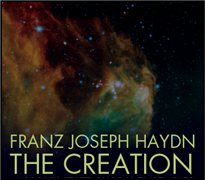 xxxxxHaydn returned to Vienna in 1795, and spent his last fourteen years there. To this period belong some of his great masterpieces, including his finest choral work The Creation. This was probably inspired during his stay in London when he attended one of the great Handel festivals. It took him two years to write - “so that my name shall live in the future” - and was rapturously received at its first public performance at Vienna in 1798. Its eerie opening, depicting the “darkness over the face of the abyss” is a most moving piece of descriptive music. The libretto was based on the Book of Genesis, and on the poem Paradise Lost, the work of the English poet John Milton. Three years later he produced his colourful oratorio The Seasons, the libretto for which was taken from the poem of that name, written by the English poet James Thompson.
xxxxxHaydn returned to Vienna in 1795, and spent his last fourteen years there. To this period belong some of his great masterpieces, including his finest choral work The Creation. This was probably inspired during his stay in London when he attended one of the great Handel festivals. It took him two years to write - “so that my name shall live in the future” - and was rapturously received at its first public performance at Vienna in 1798. Its eerie opening, depicting the “darkness over the face of the abyss” is a most moving piece of descriptive music. The libretto was based on the Book of Genesis, and on the poem Paradise Lost, the work of the English poet John Milton. Three years later he produced his colourful oratorio The Seasons, the libretto for which was taken from the poem of that name, written by the English poet James Thompson.
xxxxxHaydn showed the musical world the true potential of the symphony, string quartet and keyboard sonata. He was a master of instrumentation, and innovative over a wide variety of musical forms. In general, his music was free flowing, light hearted, and full of fresh, beautiful melodies, much of it based on old folk songs. His later compositions often revealed a greater depth of emotion, but the humour, gaiety and sparkle which typified his work overall was in contrast to the sombre mood and intensity of feeling of the early Romantic movement which was to follow, seen in the works of composers like the German Carl Maria von Weber and the Austrian Franz Schubert.
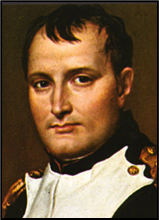 xxxxxIn 1809 Napoleon’s forces besieged Vienna and entered the city in May. The house next door to where Haydn lived had been hit by cannon fire, but he refused to leave his home and, as a mark of respect to the frail but famous composer, Napoleon (illustrated) placed a guard of honour outside his house. We are told that each day, as a mark of defiance, Haydn played his Emperor’s Hymn on his piano, a stirring song which was later adopted as the Austrian imperial anthem. He died on the last day of the month and his tomb is now in the Mount Calvary Church at Eisenstadt. In June, Mozart’s Requiem, played at his own funeral in 1791, was included in the music for Hadyn’s memorial service.
xxxxxIn 1809 Napoleon’s forces besieged Vienna and entered the city in May. The house next door to where Haydn lived had been hit by cannon fire, but he refused to leave his home and, as a mark of respect to the frail but famous composer, Napoleon (illustrated) placed a guard of honour outside his house. We are told that each day, as a mark of defiance, Haydn played his Emperor’s Hymn on his piano, a stirring song which was later adopted as the Austrian imperial anthem. He died on the last day of the month and his tomb is now in the Mount Calvary Church at Eisenstadt. In June, Mozart’s Requiem, played at his own funeral in 1791, was included in the music for Hadyn’s memorial service.
xxxxxIncidentally, Haydn journeyed to England in 1791 at the invitation of one of London’s leading impresarios named Johann Peter Salomon (1745-1815). It is for this reason that, sometimes, the London Symphonies are known as the Salomon Symphonies. ……
xxxxx…… The two years that Haydn took to compose The Creation were regarded by him as the happiest and most devout years of his life. This work, seen as the crowning glory of his later years, was in three parts, with the third section providing a glorious vision of paradise. A strong believer in the Catholic faith, he always wrote the words nomine Domini (“in the name of the Lord”) at the top of his compositions. ……
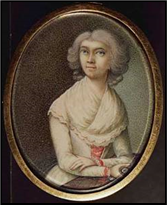 xxxxx…… Whilst Haydn’s professional career was crowned with success, it would seem that his home life was nothing short of a disaster. His wife Maria (illustrated), whom he married in 1760, proved of no comfort to him. She had not the slightest interest in music, nor in her husband’s work. We are told that she would often use his manuscripts to line cake tins, use as tablemats, or tear into strips to make curlers for her hair! It is perhaps little wonder that Haydn’s name was romantically linked, among others, with a young Italian mezzo-soprano at the court of Esterhazy. ……
xxxxx…… Whilst Haydn’s professional career was crowned with success, it would seem that his home life was nothing short of a disaster. His wife Maria (illustrated), whom he married in 1760, proved of no comfort to him. She had not the slightest interest in music, nor in her husband’s work. We are told that she would often use his manuscripts to line cake tins, use as tablemats, or tear into strips to make curlers for her hair! It is perhaps little wonder that Haydn’s name was romantically linked, among others, with a young Italian mezzo-soprano at the court of Esterhazy. ……
xxxxx…… Early on in his career Haydn met the Austrian opera composer Christoph Gluck, and in 1773 the Archduchess of Austria, Maria Theresa, visited the Esterhazys. A puppet show and opera were laid on for her, and the symphony played on that occasion (number 48) was named after her. Haydn also met Lord Nelson in 1800 and they exchanged gifts. Haydn gave Nelson a pen - presumably one he had used to write his scores - and Nelson presented Haydn with the gold watch he had with him during the Battle of Aboukir Bay two years earlier.
xxxxxThe English music critic Charles Burney (1726-1814) was a great admirer of Haydn. Although he was a talented organist, harpsichordist and composer, he is remembered today for his General History of Music, a brilliant four-volume work which was published between 1776 and 1789. This classic covered contemporary as well as earlier composers, and also gave an insight into contemporary musical taste. Two earlier works describing the “Present State of Music” on the continent were also well received. Father of the novelist Fanny Burney, he numbered among his friends William Pitt the Younger, Samuel Johnson, the Frenchman Jean Jacques Rousseau, and the king himself.
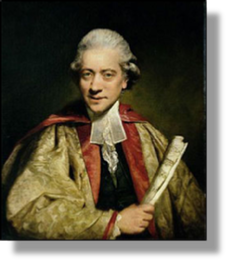 xxxxxA man who greatly admired the work of Haydn was the English organist, composer and music critic Charles Burney (1726-1814), father of the diarist Fanny Burney. He is remembered above all for his General History of Music, a work which took no less than fifteen years to write, and was published in four volumes between the years 1776 and 1789. A classic in its own time, it was universally regarded as a work of outstanding merit and marked him out as a distinguished music historian. Attractively written, it appealed to the amateur as well as the professional musician, and it dealt with contemporary music - such as that of Haydn and Mozart - as well as earlier compositions. The work was particularly informative on Renaissance music (notably on the Flemish composer Josquin des Prez), and he wrote at length upon Italian opera in England. Furthermore, and incidentally, this history also provided an interesting insight into contemporary musical taste.
xxxxxA man who greatly admired the work of Haydn was the English organist, composer and music critic Charles Burney (1726-1814), father of the diarist Fanny Burney. He is remembered above all for his General History of Music, a work which took no less than fifteen years to write, and was published in four volumes between the years 1776 and 1789. A classic in its own time, it was universally regarded as a work of outstanding merit and marked him out as a distinguished music historian. Attractively written, it appealed to the amateur as well as the professional musician, and it dealt with contemporary music - such as that of Haydn and Mozart - as well as earlier compositions. The work was particularly informative on Renaissance music (notably on the Flemish composer Josquin des Prez), and he wrote at length upon Italian opera in England. Furthermore, and incidentally, this history also provided an interesting insight into contemporary musical taste.
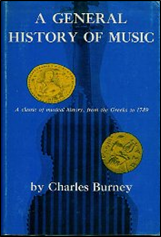
xxxxxBurney was born in Shrewsbury, Shropshire, and attended Chester Free School until the age of 16. Two years later he began studying music at Drury Lane, London, - where he probably knew Thomas Arne - and in 1749 became organist and harpsichordist for the concerts then held at the King’s Arms, Cornhill. Here his talent as a musician was soon recognised. In 1764 he was elected to the Royal Society of Arts, and in 1773, after taking a doctorate in music at Oxford, he became a Fellow of the Royal Society. In the meantime, he spent some time travelling on the continent, and this gave him material for his first success as a writer. In the early 1770s he produced a series of highly readable works on The Present State of Music in France and Italy, and then in Germany, the Netherlands and the United Provinces. These contained biographies of composers and musicians, and mixed some critical assessment with some well chosen anecdotes. It was on his return to England in 1773 that, outside of his teaching, he devoted all his time to writing his general history. He ended his career as organist at Chelsea Hospital, and, on retirement in 1805, was awarded a pension from the king.
xxxxxBurney moved in high society. His brilliant circle of friends included the king himself, the prime minister William Pitt the Younger, Samuel Johnson and the Frenchman Jean Jacques Rousseau. Following his death his valuable collection of books was acquired by Parliament, and placed in the British Museum as the Burney Library (and transferred to the British National Library in the 1990s). His novelist daughter Fanny compiled his memoirs in 1832.
xxxxxIncidentally, Burney was not the first to produce a history of music in English. This honour goes to a Middlesex magistrate named John Hawkins (1719-1789). As a writer he produced an excellent biography of his close friend Samuel Johnson in 1787, only to have it superseded by James Boswell’s masterpiece four years later! Then, after sixteen years of endeavour, in 1776 he published his five volume work entitled General History of the Science and Practice of Music. Unfortunately, this too was eclipsed a few weeks later with the appearance of Burney’s celebrated work! ……
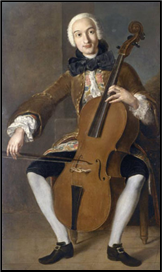 xxxxx…… Anotherxcomposer who was much influenced by Haydn’s works was the Italian Luigi Boccherini (1743-1805). Indeed, his symphonies so closely resembled those of the Austrian master - though milder in expression - that he was often given the nickname of Mrs Haydn. He specialised in chamber music for string instruments and, in particular, did much to influence the development of the string quartet, but his 500 compositions included a deal of church music, some twenty symphonies, and an opera. As a brilliant cellist, he went on extensive concert tours in Austria and France, and during his career spent a number of successful years in Paris before becoming court composer in Spain and then Prussia. Following the death of Frederick William II in 1797, he fell on hard times, and died in poverty. His music is characterised by a smooth, gentle elegance.
xxxxx…… Anotherxcomposer who was much influenced by Haydn’s works was the Italian Luigi Boccherini (1743-1805). Indeed, his symphonies so closely resembled those of the Austrian master - though milder in expression - that he was often given the nickname of Mrs Haydn. He specialised in chamber music for string instruments and, in particular, did much to influence the development of the string quartet, but his 500 compositions included a deal of church music, some twenty symphonies, and an opera. As a brilliant cellist, he went on extensive concert tours in Austria and France, and during his career spent a number of successful years in Paris before becoming court composer in Spain and then Prussia. Following the death of Frederick William II in 1797, he fell on hard times, and died in poverty. His music is characterised by a smooth, gentle elegance.
Acknowledgements
Haydn: detail, by the English portrait painter Thomas Hardy (1757-c1805), 1791/2. Birthplace: date and artist unknown – private collection. Eisenstadt: by the German artist Albert Christoph Dies (1755-1822), 1812 – Liechtenstein Museum, Vienna. Napoleon: detail, by the French painter Jacques Louis David (1748-1825), 1812 – private collection. Maria: miniature, attributed to the Austrian portrait painter Ludwig Guttenbrunn (1750-1819) – Haydn Museum, Eisenstadt, Austria. Burney: by the English portrait painter Sir Joshua Reynolds (1723-1792), 1781 – Faculty of Music Collection, Oxford University, England. Boccherini: c1764/7, artist unknown – National Gallery of Victoria, Melbourne, Australia.
G3b-1783-1802-G3b-1783-1802-G3b-1783-1802-G3b-1783-1802-G3b-1783-1802-G3b







 xxxxxThe Austrian Franz Joseph Haydn was one of the great composers of the Classical Period, alongside Wolfgang Amadeus Mozart and Ludwig van Beethoven. He has been called the father of the symphony -
xxxxxThe Austrian Franz Joseph Haydn was one of the great composers of the Classical Period, alongside Wolfgang Amadeus Mozart and Ludwig van Beethoven. He has been called the father of the symphony - Maximilian von Morzin on his estate near Pizen, Bohemia, but three years later was appointed court musician to the wealthy and influential Prince Paul Anton Esterhazy at Eisenstadt in Austria. This marked a turning point in his career. The prince died the following year, but he then stayed on in the service of his brother Miklos -
Maximilian von Morzin on his estate near Pizen, Bohemia, but three years later was appointed court musician to the wealthy and influential Prince Paul Anton Esterhazy at Eisenstadt in Austria. This marked a turning point in his career. The prince died the following year, but he then stayed on in the service of his brother Miklos - xxxxxWithin a short time of working at Eisenstadt his musical talent had come to be well known in Vienna, some 30 miles away. He made frequent visits to this city and it was here in the 1780s that he struck up a close friendship with his fellow countryman, the brilliant composer Wolfgang Amadeus Mozart, a friendship which proved of musical benefit to both men. And it was here, too, that for a brief time, having met him in 1792, he taught the equally talented German musician Ludwig van Beethoven, a man who much admired Haydn’s works.
xxxxxWithin a short time of working at Eisenstadt his musical talent had come to be well known in Vienna, some 30 miles away. He made frequent visits to this city and it was here in the 1780s that he struck up a close friendship with his fellow countryman, the brilliant composer Wolfgang Amadeus Mozart, a friendship which proved of musical benefit to both men. And it was here, too, that for a brief time, having met him in 1792, he taught the equally talented German musician Ludwig van Beethoven, a man who much admired Haydn’s works.  xxxxxWith the death of Prince Miklos in 1790, Haydn’s life changed dramatically. His son Antal had little interest in music so, although Haydn remained as music director, he was not required to provide any performances. For the first time in 30 years he was a free man. It was in that year, therefore, that he accepted an invitation to go to London for a series of public concerts. He arrived in England in 1791 -
xxxxxWith the death of Prince Miklos in 1790, Haydn’s life changed dramatically. His son Antal had little interest in music so, although Haydn remained as music director, he was not required to provide any performances. For the first time in 30 years he was a free man. It was in that year, therefore, that he accepted an invitation to go to London for a series of public concerts. He arrived in England in 1791 - xxxxxHaydn returned to Vienna in 1795, and spent his last fourteen years there. To this period belong some of his great masterpieces, including his finest choral work The Creation. This was probably inspired during his stay in London when he attended one of the great Handel festivals. It took him two years to write -
xxxxxHaydn returned to Vienna in 1795, and spent his last fourteen years there. To this period belong some of his great masterpieces, including his finest choral work The Creation. This was probably inspired during his stay in London when he attended one of the great Handel festivals. It took him two years to write - xxxxxIn 1809 Napoleon’s forces besieged Vienna and entered the city in May. The house next door to where Haydn lived had been hit by cannon fire, but he refused to leave his home and, as a mark of respect to the frail but famous composer, Napoleon (illustrated) placed a guard of honour outside his house. We are told that each day, as a mark of defiance, Haydn played his Emperor’s Hymn on his piano, a stirring song which was later adopted as the Austrian imperial anthem. He died on the last day of the month and his tomb is now in the Mount Calvary Church at Eisenstadt. In June, Mozart’s Requiem, played at his own funeral in 1791, was included in the music for Hadyn’s memorial service.
xxxxxIn 1809 Napoleon’s forces besieged Vienna and entered the city in May. The house next door to where Haydn lived had been hit by cannon fire, but he refused to leave his home and, as a mark of respect to the frail but famous composer, Napoleon (illustrated) placed a guard of honour outside his house. We are told that each day, as a mark of defiance, Haydn played his Emperor’s Hymn on his piano, a stirring song which was later adopted as the Austrian imperial anthem. He died on the last day of the month and his tomb is now in the Mount Calvary Church at Eisenstadt. In June, Mozart’s Requiem, played at his own funeral in 1791, was included in the music for Hadyn’s memorial service.  xxxxx…… Whilst Haydn’s professional career was crowned with success, it would seem that his home life was nothing short of a disaster. His wife Maria (illustrated), whom he married in 1760, proved of no comfort to him. She had not the slightest interest in music, nor in her husband’s work. We are told that she would often use his manuscripts to line cake tins, use as tablemats, or tear into strips to make curlers for her hair! It is perhaps little wonder that Haydn’s name was romantically linked, among others, with a young Italian mezzo-
xxxxx…… Whilst Haydn’s professional career was crowned with success, it would seem that his home life was nothing short of a disaster. His wife Maria (illustrated), whom he married in 1760, proved of no comfort to him. She had not the slightest interest in music, nor in her husband’s work. We are told that she would often use his manuscripts to line cake tins, use as tablemats, or tear into strips to make curlers for her hair! It is perhaps little wonder that Haydn’s name was romantically linked, among others, with a young Italian mezzo- xxxxxA man who greatly admired the work of Haydn was the English organist, composer and music critic Charles Burney (1726-
xxxxxA man who greatly admired the work of Haydn was the English organist, composer and music critic Charles Burney (1726-
 xxxxx…… Anotherxcomposer who was much influenced by Haydn’s works was the Italian Luigi Boccherini (1743-
xxxxx…… Anotherxcomposer who was much influenced by Haydn’s works was the Italian Luigi Boccherini (1743-

